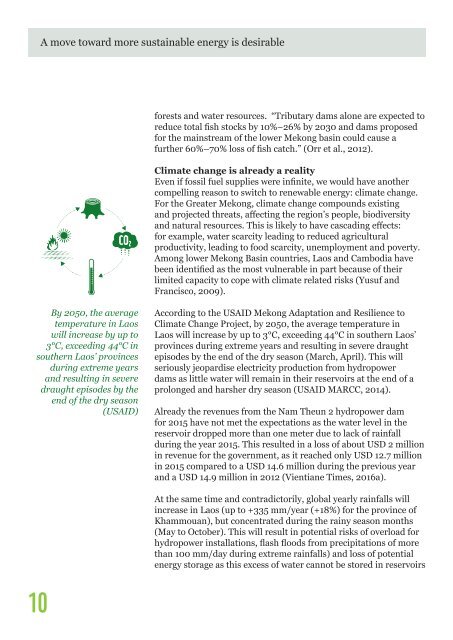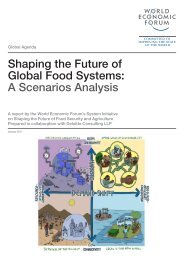Vision 2050
wwf_greater_mekong_power_sector_vision_2050
wwf_greater_mekong_power_sector_vision_2050
Create successful ePaper yourself
Turn your PDF publications into a flip-book with our unique Google optimized e-Paper software.
A move toward more sustainable energy is desirable<br />
forests and water resources. “Tributary dams alone are expected to<br />
reduce total fish stocks by 10%–26% by 2030 and dams proposed<br />
for the mainstream of the lower Mekong basin could cause a<br />
further 60%–70% loss of fish catch.” (Orr et al., 2012).<br />
Climate change is already a reality<br />
Even if fossil fuel supplies were infinite, we would have another<br />
compelling reason to switch to renewable energy: climate change.<br />
For the Greater Mekong, climate change compounds existing<br />
and projected threats, affecting the region’s people, biodiversity<br />
and natural resources. This is likely to have cascading effects:<br />
for example, water scarcity leading to reduced agricultural<br />
productivity, leading to food scarcity, unemployment and poverty.<br />
Among lower Mekong Basin countries, Laos and Cambodia have<br />
been identified as the most vulnerable in part because of their<br />
limited capacity to cope with climate related risks (Yusuf and<br />
Francisco, 2009).<br />
By <strong>2050</strong>, the average<br />
temperature in Laos<br />
will increase by up to<br />
3°C, exceeding 44°C in<br />
southern Laos’ provinces<br />
during extreme years<br />
and resulting in severe<br />
draught episodes by the<br />
end of the dry season<br />
(USAID)<br />
According to the USAID Mekong Adaptation and Resilience to<br />
Climate Change Project, by <strong>2050</strong>, the average temperature in<br />
Laos will increase by up to 3°C, exceeding 44°C in southern Laos’<br />
provinces during extreme years and resulting in severe draught<br />
episodes by the end of the dry season (March, April). This will<br />
seriously jeopardise electricity production from hydropower<br />
dams as little water will remain in their reservoirs at the end of a<br />
prolonged and harsher dry season (USAID MARCC, 2014).<br />
Already the revenues from the Nam Theun 2 hydropower dam<br />
for 2015 have not met the expectations as the water level in the<br />
reservoir dropped more than one meter due to lack of rainfall<br />
during the year 2015. This resulted in a loss of about USD 2 million<br />
in revenue for the government, as it reached only USD 12.7 million<br />
in 2015 compared to a USD 14.6 million during the previous year<br />
and a USD 14.9 million in 2012 (Vientiane Times, 2016a).<br />
At the same time and contradictorily, global yearly rainfalls will<br />
increase in Laos (up to +335 mm/year (+18%) for the province of<br />
Khammouan), but concentrated during the rainy season months<br />
(May to October). This will result in potential risks of overload for<br />
hydropower installations, flash floods from precipitations of more<br />
than 100 mm/day during extreme rainfalls) and loss of potential<br />
energy storage as this excess of water cannot be stored in reservoirs<br />
10




